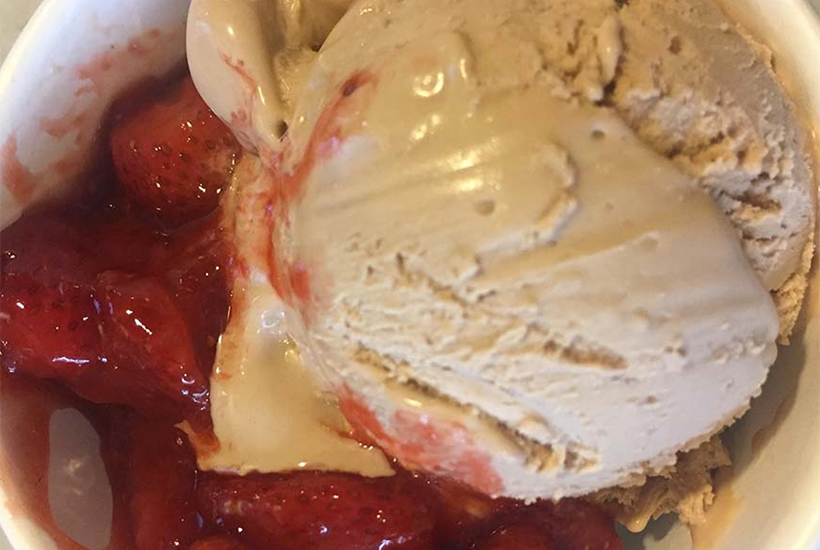 Hang on a minute, Miss Wellness — Ice Cream?
Hang on a minute, Miss Wellness — Ice Cream?
PICADILLY CREAMERY
11607 Euclid Avenue, Cleveland, Ohio (Near CWRU)
By All Means (it’s science!). My editor was a little skeptical (not to mention afraid to guess what this photo was).
I wanted to use this picture to introduce you to Molecular Gastronomy. I hear you: first ice cream, and now molecules? I hope you’ll stick with me for a few minutes.
Science teachers have been keeping kids’ attention with this stunt for years. But now, we adults (well, kids too) can share in the fun. Piccadilly Artisan Creamery in Cleveland’s University Circle delivers a dense and creamy ice cream made with organic milk from nearby Amish farms. I’m not kidding — this stuff is dense. Why? Nitrogen. Watching it happen is half the fun. Turning a ladle full of flavored milk into an air-filled semi-solid is quite a show at Piccadilly. All the flavors (including yogurt) are liquid mixtures until the moment you order. A ladleful goes into a mixing bowl, and a shot of liquid nitrogen (at minus 321 degrees) poured in as it’s mixing yields a bowl of ice cream within just a few seconds.
The nitrogen is completely safe because it evaporates instantly (more on that: keep reading). The extreme cold makes the crystals tiny… hence the incredible density. I don’t recommend this as part of your regular day–to–day meal lineup. It’s definitely a food to limit to just sometimes, or for a special occasion. The nutritional values aren’t available from the shop yet, so until I can get them, let’s assume this is not the nutritional powerhouse we normally emphasize. Check with your physician or Registered Dietitian before splurging here if your health status warrants it. Just a few bites quickly filled me up, though, so eating a small amount is very satisfying. My Silk Chocolate, topped with refreshing balsamic strawberries, was just right.
Read on to join in my excitement about the cool science part of all this!
As I mentioned, the nitrogen freezes the dairy mixture, and then evaporates. Who thinks of these things? I wasn’t convinced that it would have a pleasing texture or an ice-creamy taste, but it really did! Molecular Gastronomy is the art of marrying science with cooking in novel ways, purposely employing physical applications and principles as part of the process (not to be confused with “Mom, why does yeast make the bread rise?”).
French scientist Hervé This, reflecting on his ruined soufflé, recognized that the laws of nature apply everywhere, and when he considered their effects in food outcomes, he ran with it and attached the name. Molecular gastronomy, or culinary physics, as some prefer to call it, is enjoying a surge in popularity as both chefs and diners become more adventuresome. Think tiny spheres of olive juice and transparent ravioli.
Incorporating physics, biology and chemistry (not chemicals), the results are often entertaining and quirky. This is not artificial food, just outside-the-box preparation, and often presentation. Here’s a link to Stuff You Should Know, an entertaining podcast that will tell you much more about Molecular Gastronomy: http://www.stuffyoushouldknow.com/podcasts/how-molecular-gastronomy-works/
So, as you struggle to decide which flavor to order, you can regale your friends with your knowledge of molecular gastronomy. Reading this post has taken much longer than your ice cream will last, I promise! I hope you enjoy both.
Here’s the show — it really is fun.
There’s a dedicated bowl for each flavor (Piccadilly also keeps vegan and nut allergy items separated)
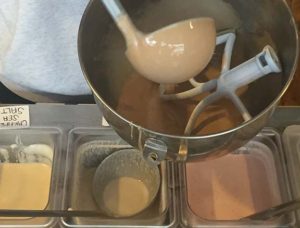
After the mixer starts, a small amount of liquid nitrogen goes in and does this …
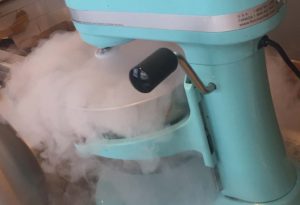
In a minute or two, here’s the result:
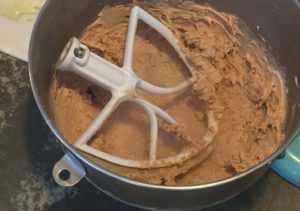
Add some roasted balsamic strawberries, and grab a spoon!
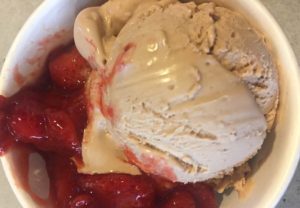
http://www.piccadillycreamery.com/
11607 Euclid Avenue, Cleveland, Ohio
In case you’d like to know, nitrogen is the 4th most common element in the human body (after oxygen, carbon, and hydrogen). It’s also the largest component of the air we breathe, by far, occupying 78% of what we walk around in all day. See? Science! You thought you’d left that in high school.